last update: 05.30.2016
"Aquaponics is the integration of aquaculture and hydroponics. An aquaculture is used to continuously generate a nutrient-rich solution to feed a hydroponic garden. Aquaponic systems can be used to replicate controlled wetland conditions that are useful for reclaiming potable water from typical household sewage, in addition to generating a continual supply of food with minimal fertilizer use. Aquaponics, which takes advantage of synergy between self-organizing biological systems, is a key element of permaculture. This synergy benefits both systems and allows each to help maintain the other. For example, an aquaponic system consisting of goldfish and watercress would require less human intervention into each system. The goldfish would benefit from the filtration carried out by the watercress, and the watercress would benefit from the nutrient-rich waste excreted by the goldfish." - old Wikipedia entry
A good book about planted aquariums is "Ecology of the Planted Aquarium, A Practical Manual and Scientific Treatise for the Home Aquarist" by Diana Walstad. The book is not strictly about aquaponics, but is definitely related.
Other good resources to research are constructed wetlands which work similiar principles, except that constructed wetlands don't generally crop for food. Also, the design of chinampas is another very similar system.
These are just my notes and experiments to find what works for me.
indoor mini system with airlift
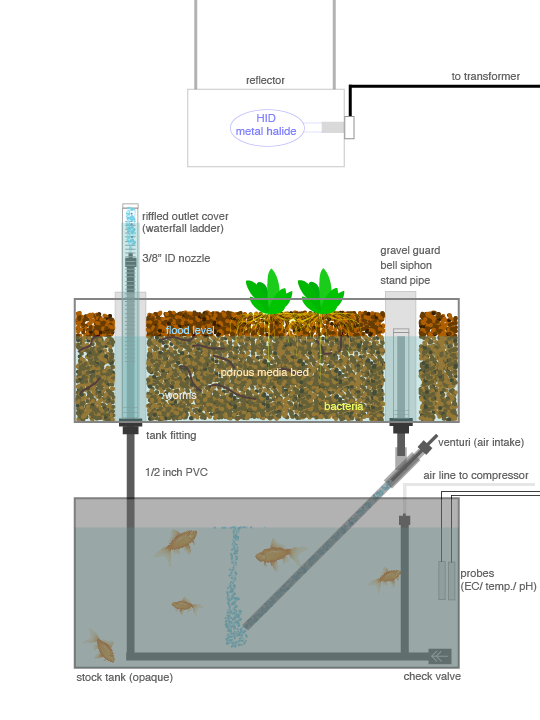
This is the latest incarnation of my small 27 gallon system. I have incorporated an airlift and a high intensity discharge (HID) metal halide lamp, as well as updated my control panel with more meters so I can do some real science.
airlift pump
Let me just state that I love using an airlift and I am now a convert from using a motorized pump for many years. However, they can be tricky, so be prepared to experiment. I played with a multitude of designs, and even built one of those "geyser" pumps. Airlifts work best when submerged in deep water, which is why I had avoided them for so long, due to the limitation on my fish tank depth of 12 inches.
However, after experimenting at such a shallow depth I came up with a design that works to my liking. Using 1/2 inch pvc pipe I was able to achieve a reliable bursty head of about 30 inches. The air compressor I am using is 27 watts using a 3/8 inch ID air line. The trick I found was to increase the length of submerged pipe before the air inlet. That is why in the diagram there is such a long length of pipe at the bottom of the tank. I did find the check valve to help as well, and I am thinking about adding an additional one. Still experimenting...
With this configuration I am averaging about 700 mL per minute which translates to 11 gallons (42 Liters) per hour. My fish tank is only 27 gallons (102 Liters) and it takes about 4 gallons (15 Liters) to kick over the bell siphon in my aggregate bed, so my bed drains around every 22 minutes. I have considerably slowed my system down which is beneficial to my setup. Before, my turnover was too fast and my evaporation rates were much too high.
One reason I like the airlift so much is that it just feels more biological, like the system is alive and breathing, visceral. One of the greatest benefits is not having to pull the direct drive pump from the fish tank for maintenance. Also, microorganisms won't get battered and killed by the pump's propeller anymore. In addition, the heat and noise from the pump is no longer transferred into the fish tank water. Plus, the energy savings...
control panel
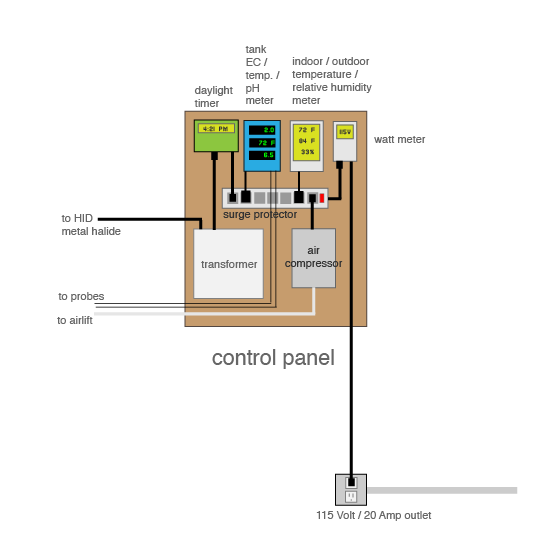
Should document my metering setup better...
indoor window system (retired)
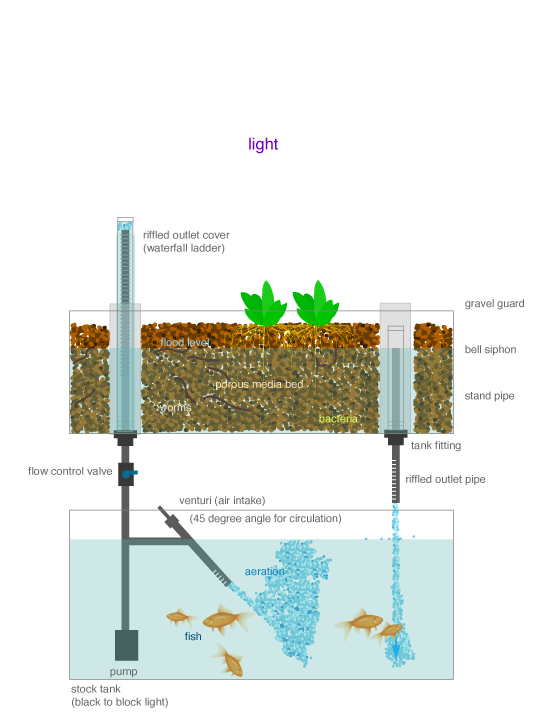
This is an experimental setup I am playing with for growing in front of a large window indoors. My design is appropriate to my individual situation, which is limited space indoors. Since I am limited by space constraints I cannot have the fish tank as the highest point in the system or implement a sump as the lowest point in the system.
Having the fish tank at the highest point has it advantages. Placing the pump in a separate sump at the lowest point in the system after the grow bed drastically reduces pump maintenance. That design is generally referred to as a CHOP (Constant Height One Pump) system, or CHIFT PIST (Constant Height In Fish Tank, Pump In Sump Tank).
My plumbing is all 1/2" PVC, thick walled, dark grey . I prefer the look of the dark grey PVC over white piping because it is visually low key and doesn't look as dirty over time.
I use a ball valve to control the flow to the media bed which helps set the timing of the flood and drain cycle and tune the bell siphon. In addition, a divergent flow is created and injected with air from a venturi intake and set tangential to the fish tank. The tangential flow creates a circulating current in the tank and lets the fish exercise, swimming against the current. Active fish means I am able to feed them more. Tangential flow will not work well with a rectangular tank, due to the 90 degree angles at the corners. These corners do no allow the water to flow smoothly around.
An optional elbow bend on the stand pipe outlet will help the bell siphon kick over to create good suction. I personally like a straight riffled pipe that drives the water straight down. This helps to drive anything settled on the bottom of the tank back into the water column.
I have experimented with an integrated settling pond within the media bed as the first stage of filtration. Here the water is again aerated by gravity, suspended solids become sedimentary and can later be removed easily. In this pond grows duckweed, snails, worms, algae, and other microorganisms.
I am coming at aquaponics from more of a bonsai approach, rather than an all out food production approach, although I do grow food in my system.

Update: I have since retired this setup. I ran this system for about three years and found it to work well. My aeration in this system was amazing, however I feel it was too amazing and have since slowed my system way down. With such a highly aerated and circulated system I was finding that my evaporation rates were too high and I was constantly having to top off the water level. By topping off so often with my hard water supply, my pH was consistently in the 7.2 to 7.5 range, and I was finding that lime scaling was occuring at a much higher rate. Upon slowing my system down by the removal of the direct drive pump and employing an airlift, my retention times are now longer and my energy requirements are much less as well.
flooded aggregate plant bed
The bed is the filter. The filter is the bed.
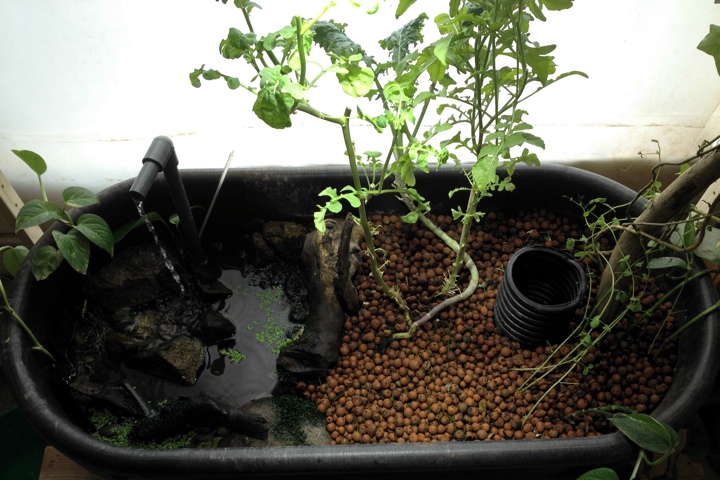
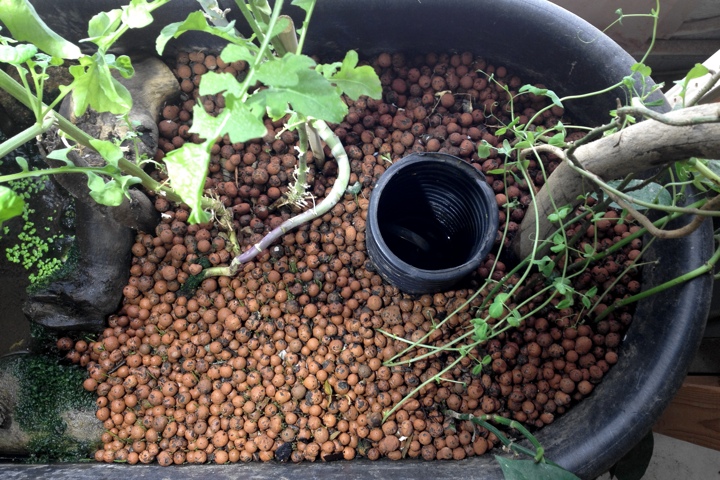
Sandstone or the commercial product Hydroton, an expanded clay pellet, makes a superb media for the planted bed, for it's porous structure and ability to absorb water. My one gripe with expanded clay media is that smaller plants are not structurally supported well in it. I really wish they made a slightly smaller expanded clay media product.
Any type of gravel works, but it gets heavy. I prefer to use a media that is rounded somewhat. When digging with your hands in sharp stones, it can hurt and is not pleasant, and if you use a pond liner for your planted bed there is always the possibility it may tear. Porous media will give you the greatest surface area which is key for the growth of beneficial bacteria. Use what is most easily available.
At some point I would like to do an experimental bed solely filled with natural sponges.
integrated settling pond (experimental)
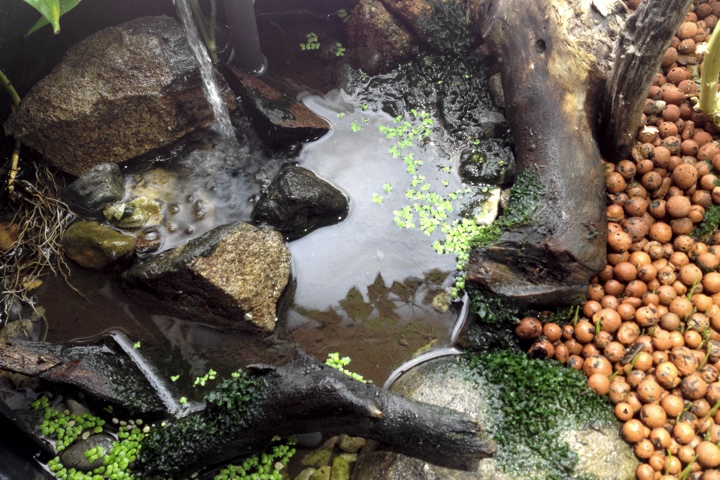
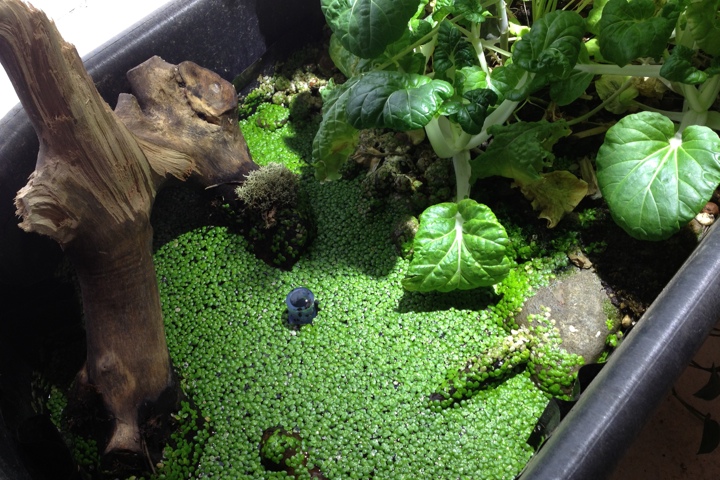
I integrated an experimental settling pond within the media bed. The pond slowly overflows into the main bed. In this pond grows snails and duckweed. I wanted a natural looking setting, so I have decomposing logs and large stones protecting the turbulent waters. The duckweed needs to be sheltered from the turbulence because it prefers more tranquil waters. The snails always seem to migrate to the interface of air and water. I occasionally flood this pond out by adjusting the diverging valve.
The pond overflow is much like an algal turf scrubber. I have string algae growing in the pond and thin it every couple of months. The string algae acts as a living filter and traps larger solids.
After a year of experimenting with this integrated settling pond, I have dismantled it and returned to directly feeding the media bed. The only advantage I found was the ability to grow duckweed within the media bed instead of a separate tank. It quickly became overrun by snails and the occasional maintenance of removing solids was not worth it for me. Also the buildup of sediment on the settling pond bottom attracted all the worms in my system.
plants
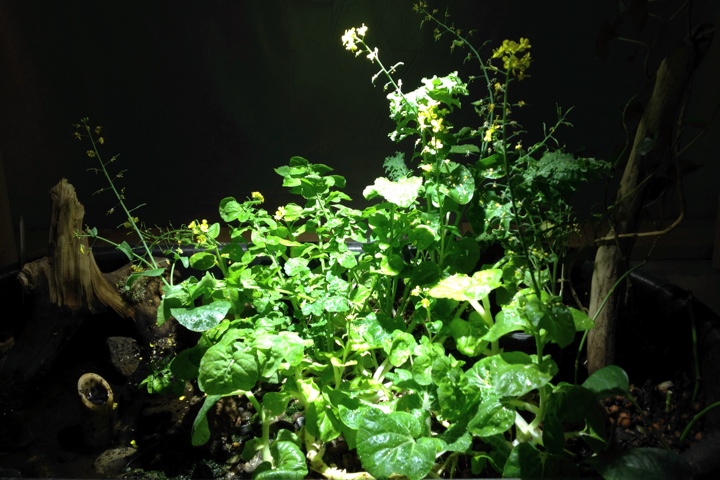
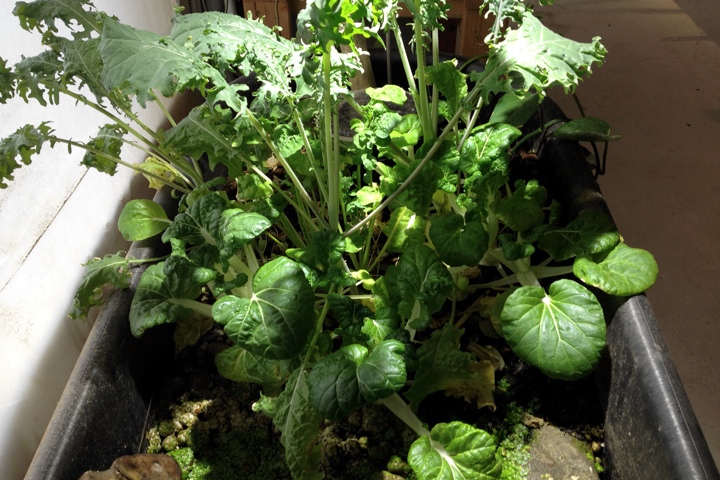
Here is some growth during the winter season. Lots of Bok Choi flowering and leafy kale. I bought heirloom seeds and decided to let some of the heads of bok choi bolt into flowering to see if I could pollinate it.
pond plants
| Common name | Scientific name |
|---|---|
| Arrowhead (duck potato, wapato) | Sagitarria latifolia |
| Bog bean (buckbean) | Menyanthes trifoliata |
| Duckweed | Lemnaoideaa |
| Water celery (Japanese parsley, Chinese celery) | Cryptotaenia japonica? |
I make no claim as to the accuracy of my notes on these plants. Plant taxonomy is very messy.
water
I use the tap water that is supplied to my building from the Boonton Reservoir located in Parsippany, New Jersey. I have also looked at the water quality information supplied by United Water so I could glean what exactly the levels of minerals are in the water and compare them to my results.
fish
I have two Koi about three years old as well as three smaller goldfish.
other organisms
| Common name | Scientific name |
|---|---|
| bladder snails | Physidae |
| nematodes | Caenorhabditis elegans |
| red wigglers | Eisenia fetida |
When the snails tend to get out control, I squash them and feed them to the fish. They hang out in the settling pond and rarely enter the planted bed.
tank pump (retired)
Because I have located my pump in the fish tank before the grow bed, overtime it does get gunked up. I do periodic maintenance once a month. Again, this would be less of issue if I had a true sump and located the pump after the grow bed as in a CHOP system.
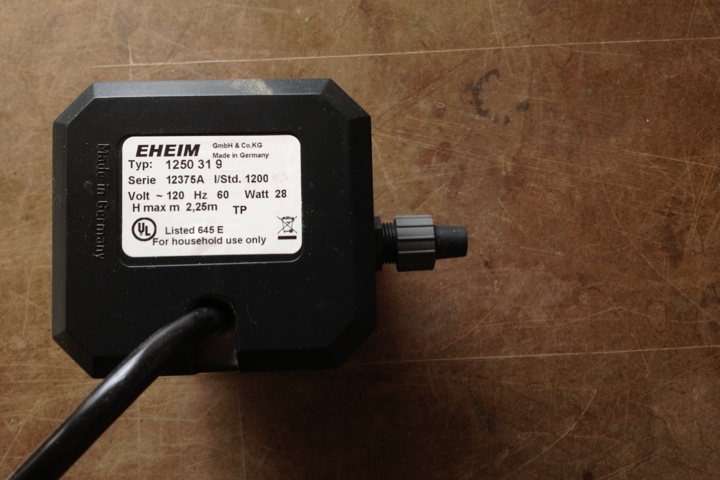
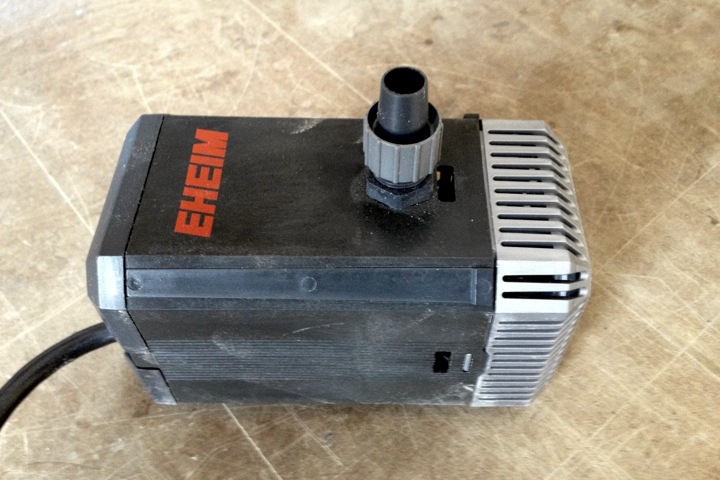
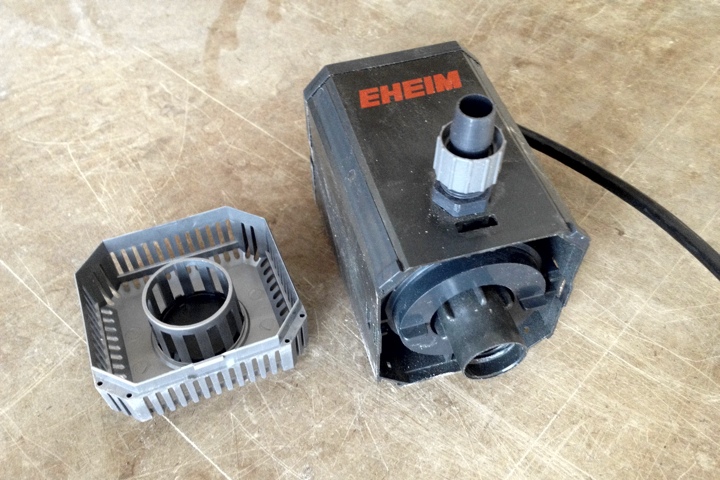
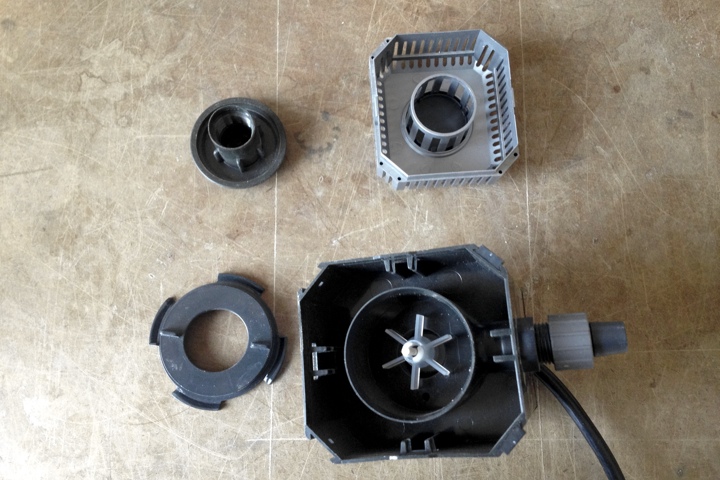
This is a magnetically driven pump or mag-drive, where the magnetic rotor rides a ceramic shaft floating within the sealed stator. Overtime I have found these pumps tend to break the ceramic bearing and wear out pretty fast in such a dirty environment. I will upgrade to a direct drive pump soon enough.
Update: After using a direct drive pump for about a year, I have since moved onto to an airlift system. The direct drive pump compared to the mag-drive was much more reliable in terms of maintenance and failure.
stock tank
I wanted a tank with curved ends so I could get better circulation around the tank using tangential flow. I have been using the tank below for about two years and it's held up well.
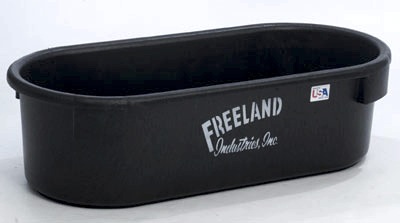
| Model #: | FBT1742 |
| Volume: | 27 Gallons |
| Weight: | 13 lbs. |
| Width: | 20 in. |
| Height: | 12 in. |
| Length: | 42 in. |
tank flow
Here are several configurations for possible tank circulation schemes.
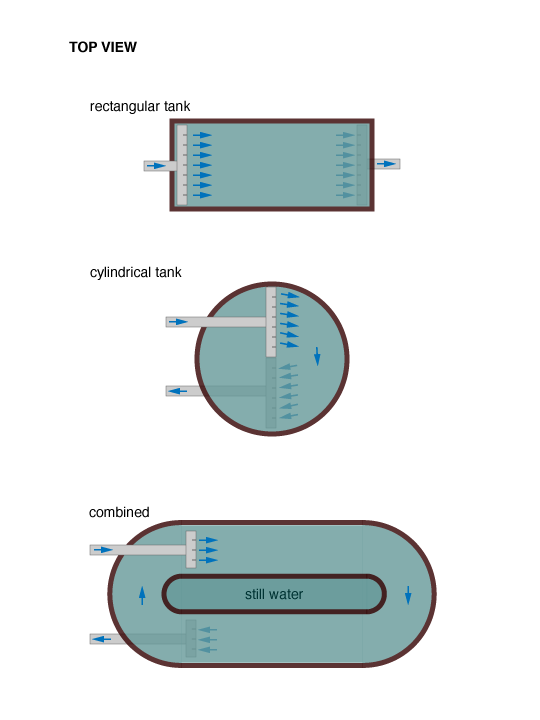
The longer rectangular tank mimics the flow of a stream and is most likely the fastest flowing of the three. The circular tank is more akin to a pond. And the last combined configuration is probably my favorite as it is the most dynamic. It allows for an inner pond with slower stagnant water which is advantageous for plants which prefer that or even may be a place for fish to breed. The inner island of the combined configuration allows for many possibilites. It also creates a greater edge and an interface between fast water and slow water.
bell siphon
Ahh, the mysterious bell siphon. The bell siphon is the muscle that controls the breathing of the planted bed.
These are the traditional bell siphon designs, which I tested to understand it's principles.
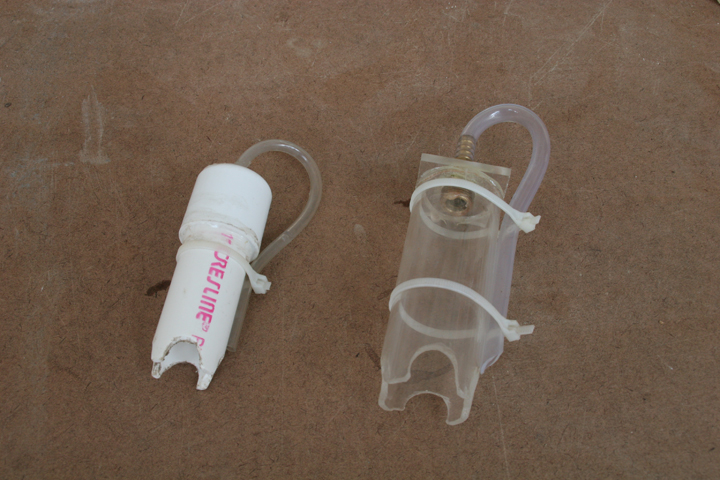
Once I had a grasp on how the bell siphon worked, I decided to experiment with something more simple. Placing the appropriate size bag over the top of a bottom slotted pipe worked amazingly well. I call it the bladder siphon. The bag should loosely fit over the pipe. The bag essentially replaces the traditional scuba tubing that is fitted to the top to break the siphon. Cheaper, no silicone, less work, lighter, easier to adjust, and more quiet. Time will tell how it stands up. I used a bag that some zip ties came in. The bladder is also much more visceral, as you can watch how gases and liquids are being exchanged. This makes me wonder if a two bladder setup over the standpipe would work. I should probably use a food grade bag as well. This bladder siphon is not as reliable as the traditional bell siphon.
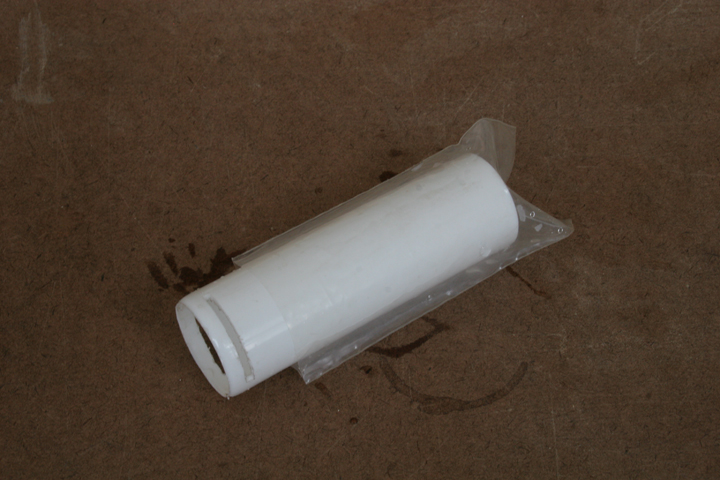
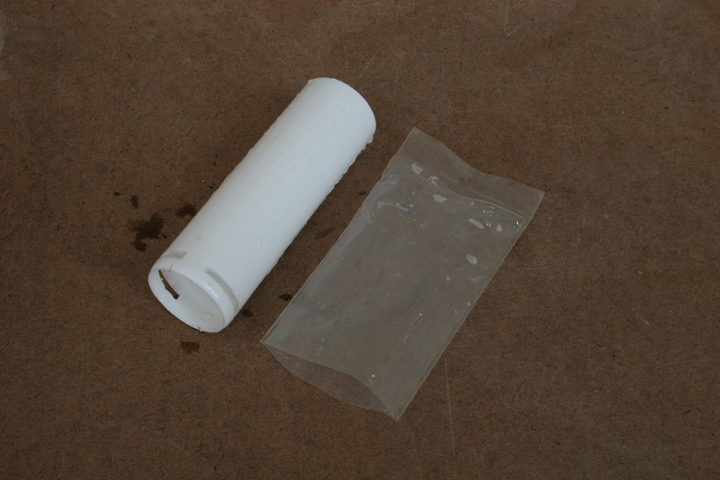
I am always striving in aquaponics to simplify and mimic nature. I am sure I can find a better fitting bag without kinks and the like, maybe the bag the fish came in, a large balloon or a condom...
In this example bell siphon you can see I have riffled or slotted the outlet pipe. This riffling in the outlet pipe creates turbulence in the fast exiting water, which is clearly seen as the water is not transparent but greatly aerated. A general rule of thumb for myself is that if I have a flow of water, I always want it in this turbulent highly aerated state. Lots of riffling creates more surface area of water to air.
experimental outlet pipes
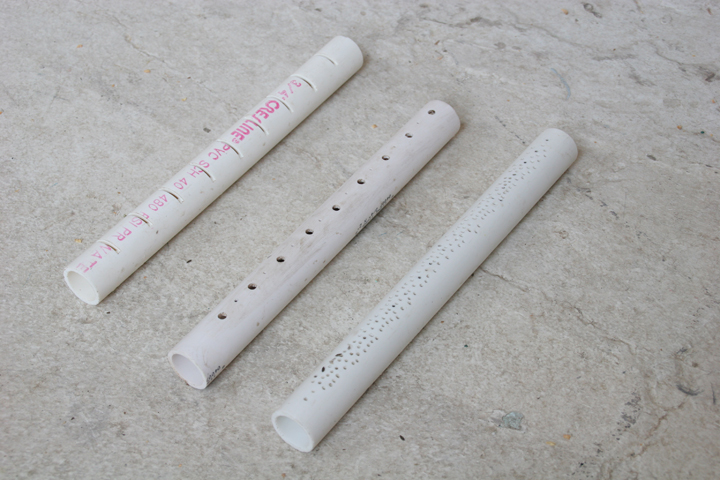
Here are several outlet pipes that I made to experiment with the flow of water from the bed to the tank. I enjoy watching the fish play in the current that is created by the out flow. I setup my outlet and inlet on tangent so as to create a circular flow in the tank, helping to mix everything.
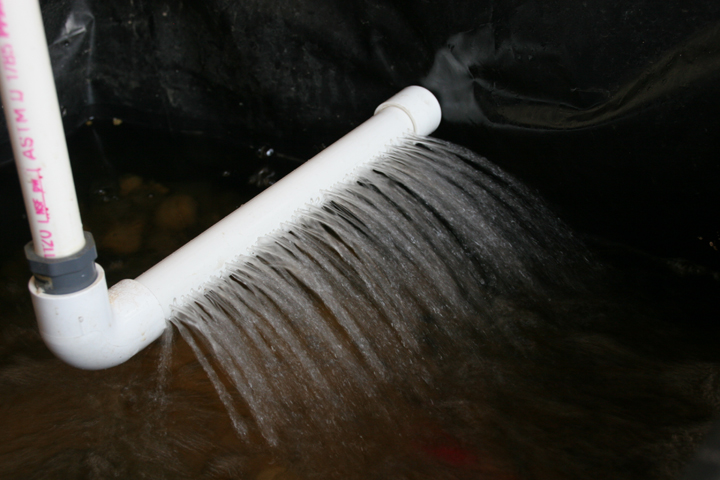
This outlet has a lot of 1/16 inch holes and provides a more fine stream of water. It tends to get clogged.
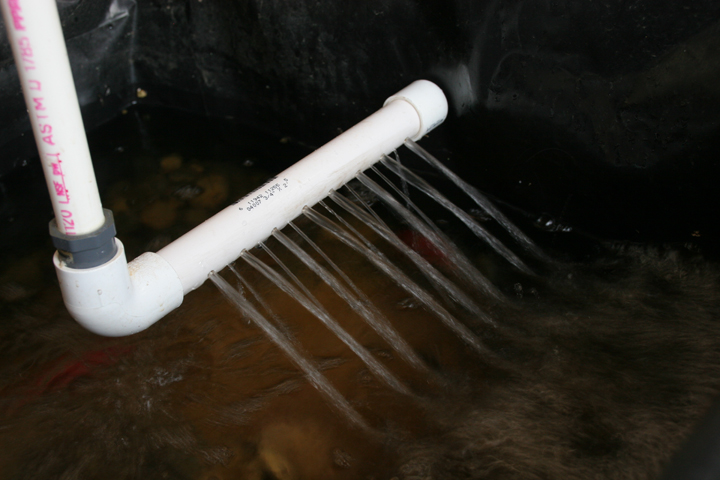
This outlet has a series of 1/4 inch and 1/16 inch holes. It has a very farty sound.
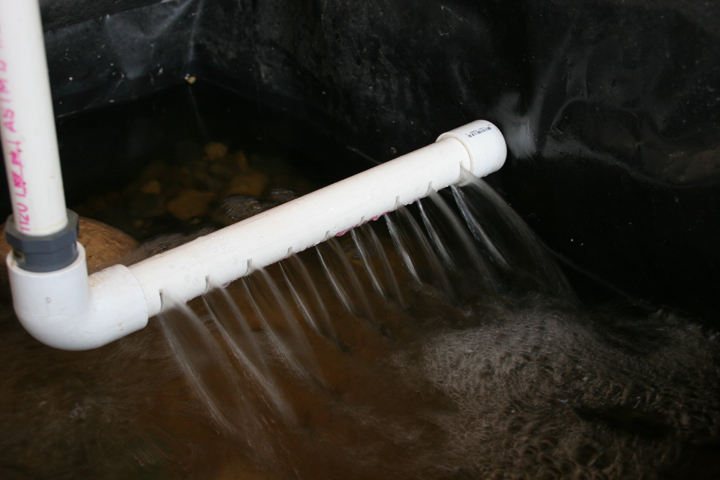
I prefer the riffled design. It separates the water into thin sheets and provides a much better surface area interface between the water and the air. I also like the sound of it. The riffled design is also very similar in shape to the lamellae within the gill of the fish. The riffled design works well in two configurations. The first, with the water current parallel to the riffle, and the second, with the water current perpendicular to the riffle. Plus, it is easier to slot the pipe on a chop saw, rather than awkwardly drilling lots of holes. I love details like this.
aeration
One point of aeration is at the diverging valve from the pump. This point circulates water tangentially in the fish tank and helps time the flood and drain cycle. I have slotted this pipe to create a riffling effect, helping to aerate the water. This riffled pipe tends to bio foul because it is located right at the pump.
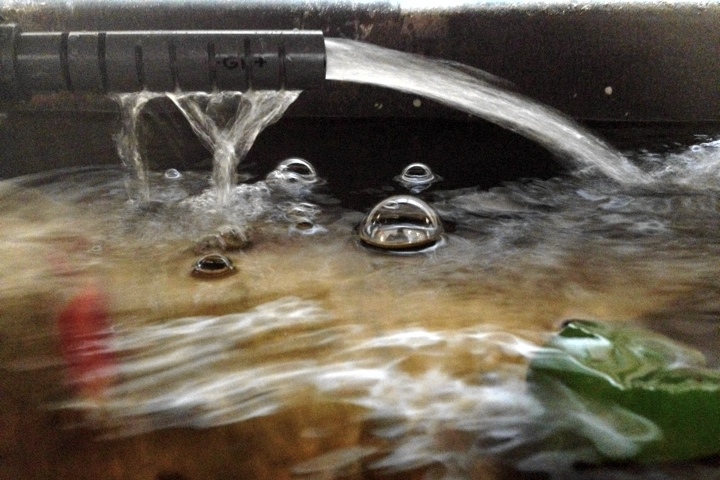
Another point is at the outlet from the bell siphon standpipe into the fish tank. Here, I prefer to use a straight slotted pipe . Much less bio fouling occurs here because this point is located after the media bed. It is interesting to watch the gas exchange happening in this riffled outlet pipe, it is very similar to a respiratory motion.
Here you can see my dissolved oxygen levels are at 7.8 mg/L, my water temperature was 69 degrees Fahrenheit, it was around 10 A.M., and I hadn't fed the fish in a day. As the water temperature lowers, dissolved oxygen rates increase. I am at sea level. This is without an air pump.

crystallization
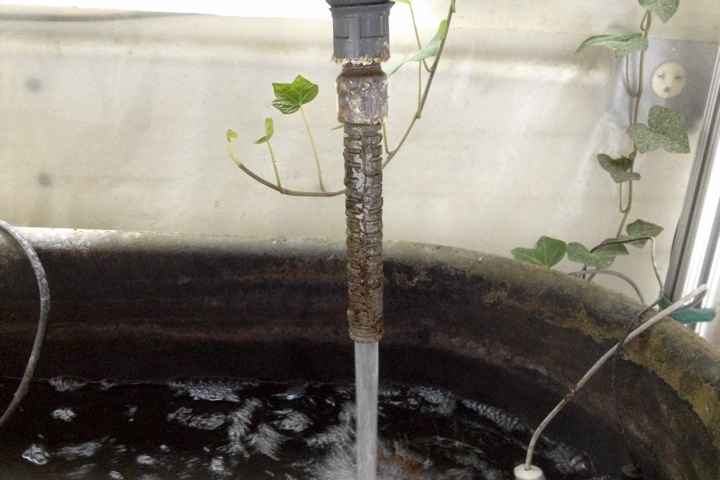
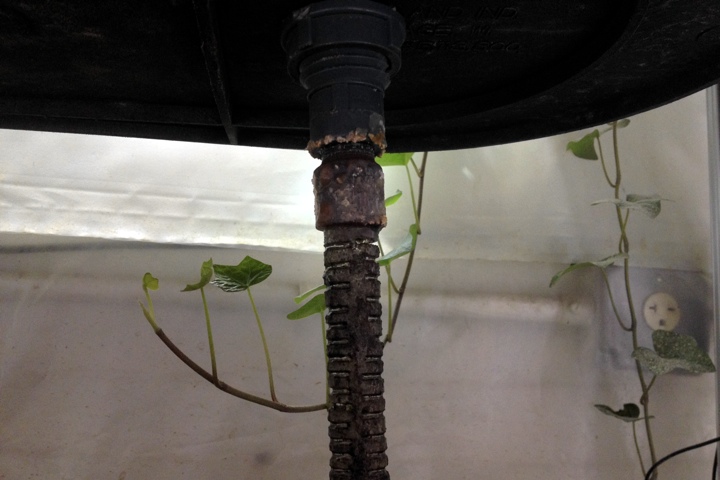
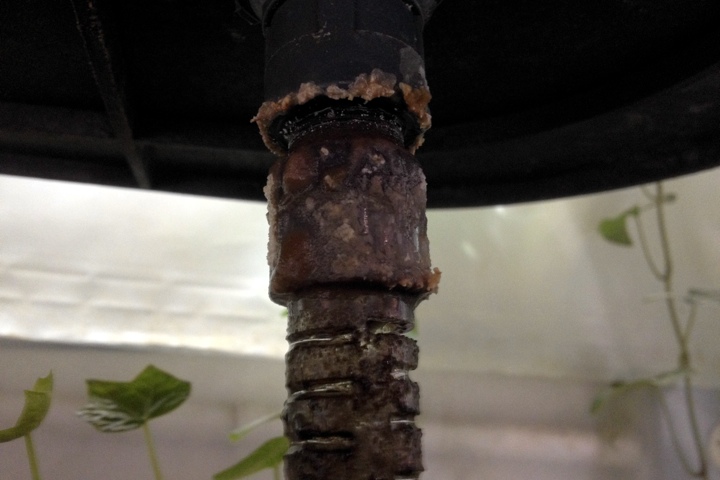
With the use of the riffled pipe, minerals crystallize and precipitate out at the outlet from the bell siphon . This is most likely calcium carbonate from the hard water source I use. I would like to investigate this further and maybe try to control this phenomenon better. Pretty cool that it is naturally forming a stalactite.
design rants
I always strive for simplicity and clarity. I try to eliminate mechanical complexity and increase biological diversity.
My design presented here has all the plumbing internal and self contained. Keeping the plumbing neat and visually low key helps a great deal to improve the aesthetic quality of the overall system. Too many times I have watched videos on the net of others' systems with their baroque complexity of over designed white PVC pipes sticking out of strings of blue barrels. One of my biggest gripes is when I see 20 cut barrels as grow beds all with individual bell siphons and outlet valving, all which could have been accomplished with a single bell siphon and a single longer grow bed. Think of it as buying a bigger capacity battery, rather than buying lots of smaller capacity batteries wired in parallel. This is an issue with scaling up.
Another often overlooked design flaw I see in many systems is the consideration of the human working environment. The system must be a pleasure to use and maintain, as well as have an efficient workflow. Too many times have I seen grow beds stacked directly on top of the fish tank making access to the fish awkward and difficult. The user interface is very important.
Some people will not like what I am about to say, but I think the dreaded IBC (Intermediate Bulk Container) tote is one of the worst design choices. It is one of the ugliest objects I have ever seen, a giant industrial cubed milk jug trapped in a cheap metal cage. For around $300, not including shipping, you get a brand new tote which can hold 330 gallons. I see its only advantage is cost. Its dimensions are essentially a cube of 1 meter x 1 meter x 1 meter. For me, fish living in a plastic caged cube is not particularly pleasing or appetizing. My eyes start to bleed when I see one. The dimensions of a cube and the dimensions of a fish are just not in visual harmony. I generally think of a fish as being in a height-length ratio of either 1 : 3 or 1 : 4. For purely aesthetic principles, the ratio of the fish tank's dimensions should be similar to that of the fish it contains. Think of it as framing the fish.
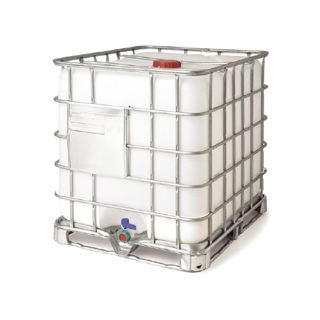
The IBC tote is most of the time semi-transparent white. If not covered or wrapped, light enters into the tank allowing for the possibility of unwanted algal blooms. Where in nature do fish swim where their whole environment is lit up on all sides? Does this well lit environment stress the fish? Also, the white container over time tends turn a garish yellow due to the nature of the fish water.
The IBC tote has to be modified, usually the top is cut and removed, then flipped over for a grow bed, and the remaining bottom is used as a fish tank. The metal cage also needs to be modified as well , sometimes leaving an unfinished look with intimidating sharp edges and points. When the IBC tote is cut, its structural integrity is compromised, and the metal cage must remain for reinforcement. These cuts never looked finished, and the edging is sharp, weak and uninviting.
How well does the metal cage survive in this wet environment? Does it rust?
The IBC tote was just not designed for this purpose. It was designed for a transportation infrastructure to move corrosive chemicals, and that is what it looks like.
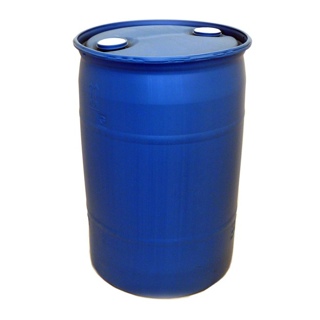
Another gripe of mine is the so called "Barrelponics". I hate terminology like this. This is a direct product of the internet. I don't call other systems "Rubbermadeponics" or "HomeDepotSteriliteContainerponics". Stop this nonsenseonics.
Again, another industrial object designed for a completely different purpose and repurposed. The barrel again has to be cut in half and modified leaving an unfinished structurally weak edge. Visually when I see these barrels I instantly think of all the waste grease sloppily poured in behind a restaurant, or the gallons of syrup being delivered to a pancake house. Due to the cylindrical nature of the barrel, biological surface area in the barrel bed is dramatically reduced, and space is wasted in between barrels in a array. Oh and that blue... that fake blue, that blue that people think is the color of water. Put three of these barrels in an aquaponic system and that is all you see, that fake blue...
These rants are my opinion, and my background is that of a visual designer so aesthetics are very important to me. I think the popularity of using these repurposed industrial objects is that they are cheap, work, and are widely available in industrialized countries and often times are recycled, which is great and get people involved in aquaponics. However I would argue that there are inherent design flaws when using these objects, and once these design flaws are recognized by the builder and or designer, the system will either be recycled into another system or dismantled altogether.
Not much is written about aesthetics in aquaponics and it is sometimes briefly touched upon, yet I think many people have a desire for a good looking system. Landscape and garden design has a long and cultured history and I think aquaponics needs to learn from that. What I think tends to happen in aquaponic design is isolation rather than integration. Aquaponics is always isolated from the landscape, rarely integrated. A great example of earth integration are the rice terraces of Satoyama, Japan. Seeing that, it is strange for me to think aquaponics was developed in the 1970s. Most aquaponic systems always have that sciencey feel, lots of pipework, valves, nozzles, tubes, all spaghettied together in some almost recognizable logic. Trying to keep all this lab equipment at bay is difficult in aquaponics. It is like when you see behind the wall of a large aquarium, all the hidden electrical wires, switches, and surge protectors growing just as well as the algae in the tank...
further reading
These are some papers that I found floating around the net and have collected. My favorite is "A Handbook of Constructed Wetlands". Enjoy.
- Recirculating Aquaculture Tank Production Systems: Aquaponics—Integrating Fish and Plant Culture
- Construction of Automatic Bell Siphons for Backyard Aquaponic Systems
- Habitat Suitability Index Models: Common Carp
- Evaluating Salinity in Irrigation Water
- Demand Fish Feeder
- Indoor Plants Effective in Reducing Airborne Particulates, Removing Pollution and Improving Air Quality
- Testing Your Aquaponic System Water: A Comparison of Commercial Water Chemistry Methods
- A Handbook of Constructed Wetlands
meta-thoughts
For a designer, be it lighting, graphic, or what have you, one requisite seems to be the use of filters. After pondering the optimal throughput and ease of use of this biological filter, I could not tear myself away from thinking about all the different types of filters. Lens filters, photoshop filters, spam filters, notch filters, audio filters, media filters, the filter in your Brita or your Mr. Coffee, or your kidneys...
Generally the filter is thought of as mechanism through which to remove material harmful to the system it is acting within. Yet, when one uses a photoshop filter, one primarily doesn't think of it as removing something harmful, but as a means to achieve a certain aesthetic or creative end. Could the original image be deemed as harmful? Harmful to the creative practice? Or is this mere semantics?
Biological filters are most effective when the material to be processed is passed through a hierarchy of stages, the first being a coarse aggregate, then less coarse, all the way through to a very fine aggregate. This lead to me a wider understanding of information control structures. Many people and organizations use news aggregators and the sort to specifically tailor their information uptake, so as to remove unwanted stories, headlines, etc., basically to remove noise, to tune in.
Tuning in, in the early days of radio, meant adjusting of the radio's coil so as to obtain the optimal level for listening enjoyment. Musicians tune their instruments. Timothy Leary's famous phrase "turn on, tune in, and drop out". Or your late night talk show host reminding you to stay tuned. Now we have the all to familiar iTunes. With the advent of digital technologies, the art of tuning is slowly being relegated to that of ham operators and classical musicians. With computers calculating quantization errors, the art of the tune is lost. The true sine is thus a blocky interpretation. The digital / analog divide.
Is tuning synonymous with filtering? Filtering removes substance, tuning changes the characteristics of the substance?